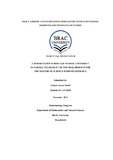| dc.contributor.advisor | Choudhury, Naiyyum | |
| dc.contributor.advisor | Ali, Liaquat | |
| dc.contributor.author | Sinthi, Nudrat Ansari | |
| dc.date.accessioned | 2016-01-18T12:47:19Z | |
| dc.date.available | 2016-01-18T12:47:19Z | |
| dc.date.copyright | 2015 | |
| dc.date.issued | 2015-12 | |
| dc.identifier.other | ID 12176010 | |
| dc.identifier.uri | http://hdl.handle.net/10361/4879 | |
| dc.description | This thesis report is submitted in partial fulfillment of the requirement for the degree of Bachelor of Science in Biotechnology, 2015. | en_US |
| dc.description | Cataloged from PDF version of thesis report. | |
| dc.description | Includes bibliographical references (page 46-58). | |
| dc.description.abstract | Association of chronic arsenic exposure with diabetes mellitus is fairly well established,
but the association of arsenic toxicity with glucose intolerance in pregnancy and with
neonatal outcome have yet not been studied adequately. The present study was
undertaken to explore the association of chronic arsenic exposure with gestational
diabetes mellitus (GDM) and neonatal outcome in a Bangladeshi population. Under an
observational cross-sectional design a total of 263 pregnant women (age in yrs, M±SD,
21±3.7) residing in an arsenic affected area of Bangladesh, were subjected to a 2 sample
OGTT at third trimester of gestation. Clinical and anthropometric measurements were
done by standard techniques. Degree of chronic arsenic exposure was assessed by the
level of As in the usable (drinking, cooking, washing and bathing) water at the
respective households and total urinary arsenic level. GDM was diagnosed by WHO
criteria and neonatal outcome was assessed using APGAR Score measured by a
Specialist Obstetrician. Serum glucose was measured by Glucose Oxidase method and
As level in water (WAs) was measured by ultraviolet/visible spectrophotometry. Out of
the 263 pregnant women 73(28%) developed GDM. WAs was significantly higher in
the GDM as compared to the Non-GDM group [WAs, ìg/l, median (range), 62(34-354)
vs 3.6(1.02-99), p<0.001]. Apger Score of the neonates from GDM mothers was
significantly lower compared to the neonates from Non-GDM mothers [APGER Score,
M±SD, 4.7±0.8 vs 6.4±0.7, p<0.001]. On Pearson’s correlation analysis in GDM
subjects, both fasting and postprandial serum glucose levels were found to have a
significant positive correlation with WAs levels (r=0.429;p=<0.001) and water arsenic
and also significant positive correlation with water arsenic (r=0.234; p<0.001). The
APGER Score of the neonates were found to have a significant negative correlation (r=-
0.233; p=0.041) with WAs level. Chronic arsenic exposure is associated with worsening
of glucose intolerance during pregnancy and it also affects neonatal outcome in an
adverse way. | en_US |
| dc.description.statementofresponsibility | Nudrat Ansari Sinthi | |
| dc.format.extent | 81 pages | |
| dc.language.iso | en | en_US |
| dc.publisher | BRAC University | en_US |
| dc.rights | BRAC University thesis are protected by copyright. They may be viewed from this source for any purpose, but reproduction or distribution in any format is prohibited without written permission. | |
| dc.subject | Biotechnnology | en_US |
| dc.title | Daily arsenic contamination associated with Gestational diabetes mellitus and neonatal outcome | en_US |
| dc.type | Thesis | en_US |
| dc.contributor.department | Department of Mathematical and Natural Science, BRAC University | |
| dc.description.degree | M. Biotechnology | |

